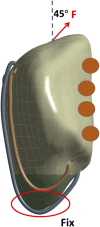Computational evaluation of wire position using separate vertical wire technique and candy box technique for the fixation of inferior pole patellar fractures: a finite element analysis
- PMID: 38720880
- PMCID: PMC11076871
- DOI: 10.3389/fbioe.2024.1353901
Computational evaluation of wire position using separate vertical wire technique and candy box technique for the fixation of inferior pole patellar fractures: a finite element analysis
Abstract
The separate vertical wire (SVW) technique and the improved candy box (CB) technique have been proposed for treating inferior pole patellar fractures. However, there is still a lack of clear explanation regarding the location of the wire passing through the patella. Five models of SVW techniques were established in different positions. Finite element analysis was then conducted to determine the optimal bone tunnel position for the SVW technique. Based on these findings, six groups of finite element models were created for CB techniques. The maximum displacement and stress on both the patella and steel wire were compared among these groups under 100-N, 200-N, 300-N, 400-N, and 500-N force loads. The results indicated that, in the SVW technique, the steel wire group near the fracture end of the longitudinal bone tunnel showed minimal displacement and stress on the patella when subjected to different forces. On the other hand, in the CB technique, both the patella and wire experienced minimal stress when a transverse bone tunnel wire was placed near the upper posterior aspect of patella. In conclusion, the SVW technique may require the bone tunnel wire to be positioned near the fractured end of the lower pole of the patella. On the other hand, in CB technique, the transverse bone tunnel wire passing through the patella may be close to its upper posterior aspect. However, further validation is necessary through comprehensive finite element analysis and additional biomechanical experiments.
Keywords: candy box technique; finite element analysis; inferior pole patellar fractures; separate vertical wire technique; wire position.
Copyright © 2024 Fan, Dang, Tan, Liu, Yang and Xiang.
Conflict of interest statement
The authors declare that the research was conducted in the absence of any commercial or financial relationships that could be construed as a potential conflict of interest.
Figures





References
-
- Chen C. H., Chen Y. N., Li C. T., Chang C. W., Chang C. H., Peng Y. T. (2019). Roles of the screw types, proximity and anterior band wiring in the surgical fixation of transverse patellar fractures: a finite element investigation. BMC Musculoskelet. Disord. 20 (1), 99. 10.1186/s12891-019-2474-7 - DOI - PMC - PubMed
LinkOut - more resources
Full Text Sources

